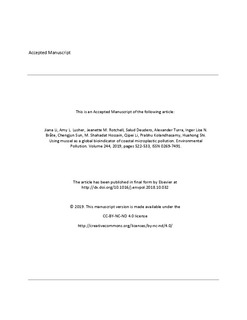| dc.contributor.author | Li, Jiana | |
| dc.contributor.author | Lusher, Amy L | |
| dc.contributor.author | Rotchell, Jeanette M. | |
| dc.contributor.author | Deudero, Salud | |
| dc.contributor.author | Turra, Alexander | |
| dc.contributor.author | Bråte, Inger Lise N | |
| dc.contributor.author | Sun, Chengjun | |
| dc.contributor.author | Hossain, M. Shahadat | |
| dc.contributor.author | Li, Qipei | |
| dc.contributor.author | Kolandhasamy, Prabhu | |
| dc.contributor.author | Shi, Huahong | |
| dc.date.accessioned | 2019-12-05T07:14:11Z | |
| dc.date.available | 2019-12-05T07:14:11Z | |
| dc.date.created | 2019-03-14T14:26:47Z | |
| dc.date.issued | 2019 | |
| dc.identifier.citation | Environmental Pollution. 2019, 244, 522-533. | nb_NO |
| dc.identifier.issn | 0269-7491 | |
| dc.identifier.uri | http://hdl.handle.net/11250/2631828 | |
| dc.description | Embargo until 09 October 2020 | nb_NO |
| dc.description.abstract | The ubiquity and high bioavailability of microplastics have an unknown risk on the marine environment. Biomonitoring should be used to investigate biotic impacts of microplastic exposure. While many studies have used mussels as indicators for marine microplastic pollution, a robust and clear justification for their selection as indicator species is still lacking. Here, we review published literature from field investigations and laboratory experiments on microplastics in mussels and critically discuss the suitability and challenges of mussels as bioindicator for microplastic pollution. Mussels are suitable bioindicator for microplastic pollution because of their wide distribution, vital ecological niches, susceptibility to microplastic uptake and close connection with marine predators and human health. Field investigations highlight a wide occurrence of microplastics in mussels from all over the world, yet their abundance varies enormously. Problematically, these studies are not comparable due to the lack of a standardized approach, as well as temporal and spatial variability. Interestingly, microplastic abundance in field-collected mussels is closely related to human activity, and there is evidence for a positive and quantitative correlation between microplastics in mussels and surrounding waters. Laboratory studies collectively demonstrate that mussels may be good model organisms in revealing microplastic uptake, accumulation and toxicity. Consequently, we propose the use of mussels as target species to monitor microplastics and call for a uniform, efficient and economical approach that is suitable for a future large-scale monitoring program. | nb_NO |
| dc.language.iso | eng | nb_NO |
| dc.publisher | Elsevier | nb_NO |
| dc.rights | Attribution-NonCommercial-NoDerivatives 4.0 Internasjonal | * |
| dc.rights.uri | http://creativecommons.org/licenses/by-nc-nd/4.0/deed.no | * |
| dc.title | Using mussel as a global bioindicator of coastal microplastic pollution | nb_NO |
| dc.type | Journal article | nb_NO |
| dc.type | Peer reviewed | nb_NO |
| dc.description.version | acceptedVersion | nb_NO |
| dc.source.pagenumber | 522-533 | nb_NO |
| dc.source.volume | 244 | nb_NO |
| dc.source.journal | Environmental Pollution | nb_NO |
| dc.identifier.doi | 10.1016/j.envpol.2018.10.032 | |
| dc.identifier.cristin | 1684823 | |
| cristin.unitcode | 7464,20,19,0 | |
| cristin.unitcode | 7464,20,13,0 | |
| cristin.unitname | Miljøgifter | |
| cristin.unitname | Økotoksikologi | |
| cristin.ispublished | true | |
| cristin.fulltext | postprint | |
| cristin.qualitycode | 1 | |

